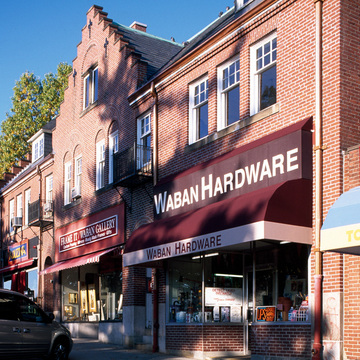William C. Strong, one of the chief promoters of Waban, capitalized on an already developing residential neighborhood laid out in 1889. After the Boston & Albany Railroad erected a passenger station here (since demolished), Strong in 1896 erected a commercial block on Beacon Street within clear sight of the
Notwithstanding Strong's efforts, the Waban commercial district developed rather slowly. It was not until 1924 that the row of one-story shops was added (1629–1639 Beacon Street). With the Strong Block having established a northern European architectural theme, Edward B. Stratton followed suit with Tudor and Jacobean motifs. In the same decade the Tudor-style branch library and local school were also erected in Waban Village. Of all the Newton villages, only Waban has a village center with a strong architectural consistency.















